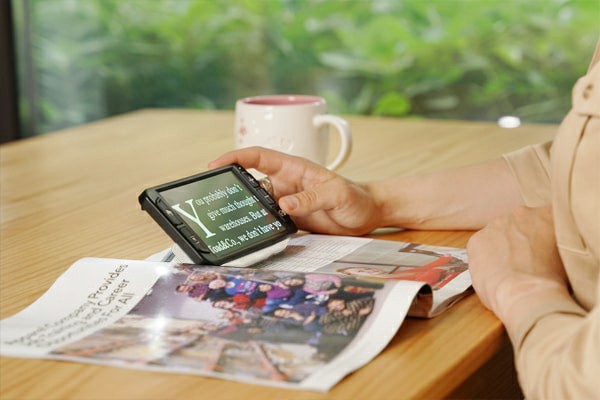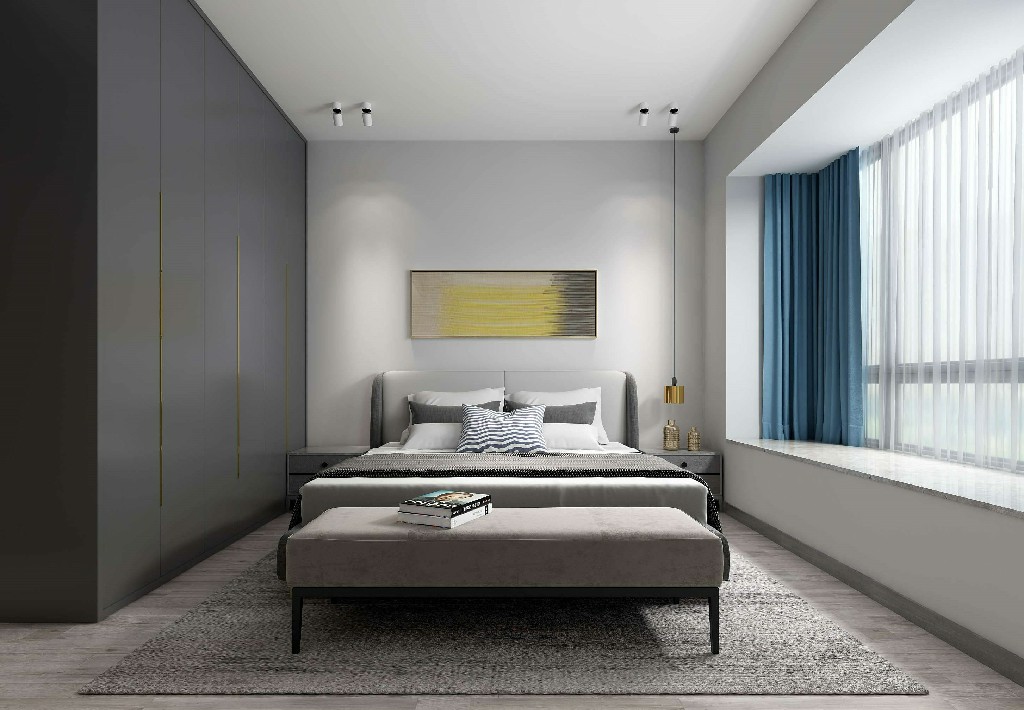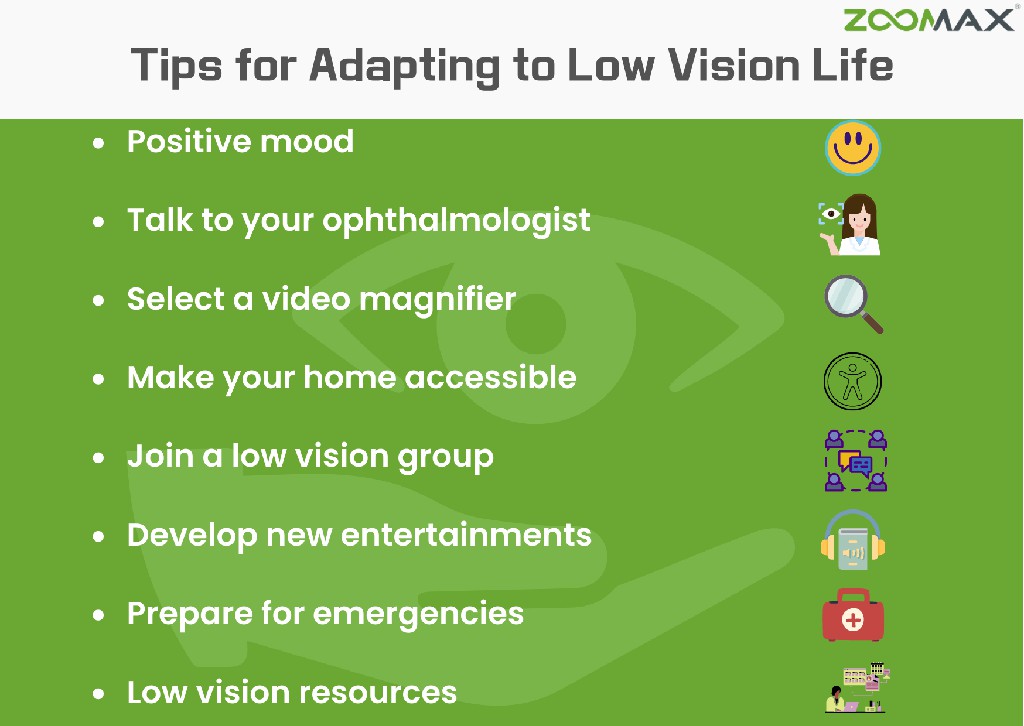Dealing with low vision life presents challenges in many ways, some obvious, some less so. However, while there are different types of low vision, one thing everyone living with low vision shares, is the challenges in adapting to the condition after it occurs. As a life changing moment, developing low vision for whatever reason means real disruption in anyone’s life, here are some ways that can make the transition to low life living less stressful.

Common situations that lead to low vision
There are a number of causes of low vision, and it can affect people at any age. However, you can break those causes down into two types, accidents or disease. Accidents can happen to anyone at any time, and if it results in injury to the eye, that can cause 20/200 vision or a range of other low vision conditions. But that is not all, while eye injuries are the obvious cause of low vision from accidents, blows to the head or other causes of brain injuries can have a similar outcome, leading to someone having to adapt to a low vision life. Diseases cause visual impairment too, and there are several common conditions that can lead to low vision life.
- Macular Degeneration
Affecting the retina, Macular Degeneration causes a slow loss of vision over time, and is usually associated with the aging process.
- Cataracts
This is where the lens becomes cloudy, either as a whole or in part. Because the cluding reduces the amount of light that reaches the retina, it causes a loss of vision that gets worse as the clouding intensifies.
- Glaucoma
This disease affects the optic nerve itself and is often caused by issues with the flow of fluid within the eye.

In addition to these, other problems include Diabetic Retinopathy, Amblyopia, Retinal Detachment, and retinitis, Pigmentosa. With so many different reasons for the cause, it shouldn’t be a surprise that there are a number of types of low vision that can occur as a result. These include a loss of central vision and loss of side, or peripheral, vision, which explain themselves. There are other types of low vision too, blurred vision that means everything is out of focus all the time, even with corrective glasses, and night blindness that makes it almost impossible to see in dimly lit situations, not just at night.
There are two more types of low vision life can throw at us, reduced contrast sensitivity that gives a haze like appearance to what they see, and glare light sensitivity, where normal light levels can overwhelm the visual system leaving the person’s vision seemingly washed out or full of glare. In severe cases, this can even be painful to the sufferer.
The difficulties faced when living with low vision
While low vision life impacts almost everything you do, there are some notable areas where it can be incredibly difficult to cope and where aids and guidance can make a real difference. The inability to read and write as you used to do is perhaps the most impactful, as it has such a profound effect on how we live from day to day. Email, work, just discovering a new book or website that you enjoy are things that suddenly become so much more difficult to accomplish.
 This is exacerbated by the lack of low vision resources to help in these and other situations. While you may be able to ask for Ophthalmologist suggestions to help you, the chances of being able to find an accessible home for low vision or other support structures to help you get used to low vision are low. This is even more of an issue given the nature of low vision life, as it impacts everything we do, making it very difficult to get used to in the beginning. But there are things you can do, and tools out there to help. While the transition is always going to be a challenge, here are 8 tips to help you adapt to low vision life.
This is exacerbated by the lack of low vision resources to help in these and other situations. While you may be able to ask for Ophthalmologist suggestions to help you, the chances of being able to find an accessible home for low vision or other support structures to help you get used to low vision are low. This is even more of an issue given the nature of low vision life, as it impacts everything we do, making it very difficult to get used to in the beginning. But there are things you can do, and tools out there to help. While the transition is always going to be a challenge, here are 8 tips to help you adapt to low vision life.
8 Tips for Adapting to Low Vision Life
- Positive mood
 While not a direct solution for living with low vision, maintaining a positive mood can make a real difference in these early stages. It can be very easy to feel overwhelmed and think things are not going to get better, but you will adapt and learn to live a low vision life. Staying positive can be a big boost to the effort you put in and help you achieve your goals faster.
While not a direct solution for living with low vision, maintaining a positive mood can make a real difference in these early stages. It can be very easy to feel overwhelmed and think things are not going to get better, but you will adapt and learn to live a low vision life. Staying positive can be a big boost to the effort you put in and help you achieve your goals faster.
- Talk to your ophthalmologist
You may be the only person in your family or friends to have this problem, and it can feel isolating to go through, leaving you a little lost with how to proceed. However, you can ask for ophthalmologist suggestions for things you can do, the best tools you need and so on. Professional advice from someone you can trust, like staying positive, can be a boost to confidence and really help you adapt.
- Select a video magnifier
A video magnifier may be the most versatile and useful tool to aid with the many difficulties for low vision living. Working for sight both up close and at a distance, they allow varied magnification to suit your specific need in any situation. With the ability to adjust brightness, contrast and more, a video magnifier is the perfect aid.
Choosing one is all about your needs. Do you want something portable for use, what kind of magnification will you need the most? If you like to cook and want to read recipes in the kitchen for instance, a portable unit is much more useful, but in some cases, a larger, non-portable option may fit your needs. There are so many low vision aids options, as long as you have it clear in your mind what you need, there will be something to suit.
- Make your home accessible
 There are a number of things you can do to help living with low vision around the home. It may not be practical to change all your furniture, however by using throws, paint and so on, you can create an environment with more color and contrast to help you create a more accessible home for low vision life.
There are a number of things you can do to help living with low vision around the home. It may not be practical to change all your furniture, however by using throws, paint and so on, you can create an environment with more color and contrast to help you create a more accessible home for low vision life.
Think about each object. If your table is dark colored, paint the edges in a lighter, contrasting color, this clearly defines the boundaries of the object for you. Not only does this help navigate around the home, but helps you know what each piece is. For more ways to make your home accessible, please check: 6 Ways to Make Home More Accessible for People with Low Vision.
- Join a low vision group
While your friends and family will no doubt be as supportive as they can, there is nothing quite like sharing your ideas and concerns with others in the same situation. Joining a group for low vision life can be one of the best things you do, not just for practical advice, but support from others who understand how you are feeling can make all the difference when you have a bad day.
- Develop new entertainments
Talking books and other low vision aids can be a real help. One of the challenges of adapting to living with low vision can be a sense that you can no longer do all the things you loved to do before. But by embracing new types of entertainment, whether that is replacing your favorite novels with speaking versions, or finding something completely different to try, you can still spend time in an enjoyable way.
There are a number of board games, card games and so on made for low vision life, and some sports, such as fishing, can be a fun challenge to try. Cooking is another pastime that can be a great way to keep entertained, and with care, you can create an environment that lets you enjoy the pleasures of gardening safely too.
- Prepare for emergencies
This may seem counter intuitive, when adapting to low vision living is it wise to focus on what might go wrong? The reality is that having everything in place for an emergency gives you confidence, knowing you can take care of an issue if it does arise. There are three essential aspects to cover with your emergency plan, these are:
Personal: Keep a three-day water supply where you can access it.
Your Home: Keep crucial survival items, such as clothes, tins of food and so on, in easily accessible places so you can get to them quickly if needed.
Your community: Understand the resources and procedures in place to help disabled community members in the case of an emergency, and know how to access them.
- Low vision resources
Make full use of any low vision resources that are available to you, and seek out as much information as you can from websites, groups and so on. Having as much information, guidance and support as possible makes adapting to low vision life easier. That in turn makes your long term living with low vision a less daunting prospect.

References:
https://www.allaboutvision.com/lowvision/10-ways-to-cope/
https://www.allaboutvision.com/lowvision/new-vision-technology/
https://www.aoa.org/healthy-eyes/caring-for-your-eyes/low-vision-and-vision-rehab?sso=y
https://visionaware.org/blog/visually-impaired-now-what/five-steps-for-adjusting-to-low-vision/

